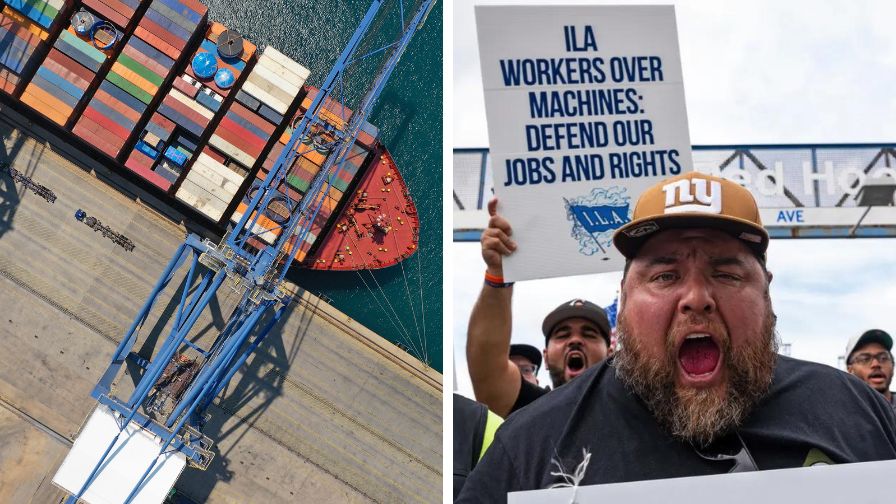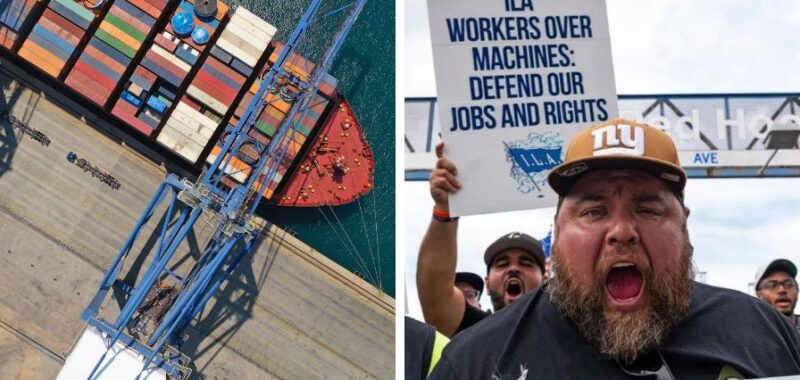
A top-down image of an industrial cargo container ship (L) and ILA striking dockworkers in Brooklyn, NY (R) | Aerial-Drone, via Adobe Stock; Spencer Platt, via Getty Images
This morning, on Friday, Oct. 4, 2024, U.S. dockworkers, from Maine to Texas, returned to work. The 2024 U.S. Port Strike, which began on Tuesday, Oct. 1, 2024, concluded after the International Longshoremen’s Association (ILA) labor union reached a tentative agreement on an increase in wages with shipping companies. For the time being, the strike will be suspended until Jan. 15, 2025, giving the union and shippers, represented by the U.S. Maritime Alliance (USMX), time to hammer out the details and negotiate a new six-year contract.
The strike, which organized roughly 45,000 dockworkers across the U.S. East Coast and Gulf Coast, initially led to strong fears from economists. Many warned that a prolonged dispute, featuring delayed and halted shipments, could lead to certain product shortages and, thereby, increased prices throughout various industries and consumer bases, including those in agriculture and horticulture businesses.
“Each day that this goes on it creates a backlog of containers and ships,” says American Farm Bureau Federation Economist Daniel Munch, via CBS News. “A three-to-five-day strike will take two weeks to clear — if it goes into three-week territory, it will be early January before it gets cleared.”
However, the dockworkers clearly had a different view on the importance of the matter. Harold Daggett, International President of the ILA, voiced his concerns at the beginning of the dispute, as reported by the Wisconsin Examiner.
“These greedy corporations, everything they got, they got from us. We’re the ones who worked through the pandemic to make them the money they got.”
Beyond wages, the other main concern of the strike was the increasing fear of automation and artificial intelligence taking away jobs from human workers.
“The rest of the world is looking down on us because we’re fighting automation,” says Daggett, as reported by CNN. “Remember that this industry, this union, has always adapted to innovation. But we will never adapt to robots taking our jobs.”
Publicly, the White House and President Joe Biden supported the effort of the U.S. dockworkers during the strike, urging the port and shipping companies to offer a better package to swiftly end the dispute.
“They made incredible profits, over 800% profit since the pandemic, and the owners are making tens of millions of dollars from this,” Biden voiced to reporters on Wednesday, as reported by Reuters. “It’s time for them to sit at the table and get this strike done.”
Meanwhile, the USDA released the following statement upon the dawn of the strike on Tuesday:
“The Administration is taking action to monitor and address potential impacts on consumers due to labor disputes at East Coast and Gulf Coast ports. Our analysis shows we should not expect significant changes to food prices or availability in the near term. Thanks to the typically smooth movement through the ports of goods and our strong domestic agricultural production, we do not expect shortages anytime in the near future for most items. Likewise, non-containerized bulk export shipments, including grains, would be unaffected by this strike. For meat and poultry items that are exported through East and Gulf Coast ports, available storage space and re-direction of products to alternative domestic and international markets can alleviate some of the pressure on farmers and food processors.”
“We are keeping an eye on downstream impacts in the west, and we will continue to monitor and work with industry to respond to potential impacts. Our Administration supports collective bargaining as the best way for workers and employers to come to a fair agreement, and we encourage all parties to come to the bargaining table and negotiate in good faith—fairly and quickly.”
So, now that the strike is over, what does it mean for the horticulture industry, both in the immediate aftermath and in the future?
Aftermath Effects on Agriculture and Horticulture
Immediate effects of logistical complications from delayed shipments are still likely to affect several industries in the U.S. market, though not nearly to the extent had the port strike extended beyond a week.
As reported by Time, the top products most at risk for shortages and price increases as a result of the strike include:
- Alcohol
- Auto parts
- Chocolate
- Electronics
- Fruit
- Medical supplies
- Shoes
Some of these products fall under the purview of growers in agriculture and horticulture, though the effects on all industries that manufacture, ship, and sell these products should likely be minimal due to the short stint of the strike.
However, these industries and more still must reckon with the impacts of Hurricane Helene and the recovery efforts currently underway.
Additionally, dockworkers’ concern for the proliferation and infiltration of automation, artificial intelligence, and robotics is an increasing concern that many industries must grapple with. As proven by the agricultural sector, the proper adoption of automation can help to improve the efficiency and safety of employees. However, the replacement of a workforce en masse by technology, if it ever becomes a viable option for companies in the future, is likely to pose additional labor disputes and tremendous implications for the world economy.
New Dockworkers Contract Details and Statements from Presidential Candidates
The current and tentative deal of the agreement made between the ILA and USMX is for a 61.5% increase in wages over six years. Initially, as reported by Reuters, the ILA was seeking a 77% raise, while the USMX was proposing just under a 50% raise.
As previously stated, the details of the new contract will be negotiated. If a deal isn’t met by Jan. 15, 2025, a return to the strike is likely.
“This is the first strike in 50 years — these people know how to get to yes,” says Secretary of Agriculture Tom Vilsack, speaking to reporters aboard Air Force One via the Wall Street Journal. “They just need to get to yes.”
President Biden released a statement, saying, “Collective bargaining works, and it is critical to building a stronger economy from the middle out and the bottom up.”
Vice President Kamala Harris also released a statement, covered by The Guardian, saying “As I have said, this is about fairness – and our economy works best when workers share in record profits. Dockworkers deserve a fair share for their hard work getting essential goods out to communities across America.”
Former President Donald Trump put out a statement on his website on Tuesday, blasting Kamala Harris for causing the strike due to inflation brought on by out-of-control spending decisions, but has not, at the time of writing, made a statement regarding the conclusion of the strike and the tentative union deal.

